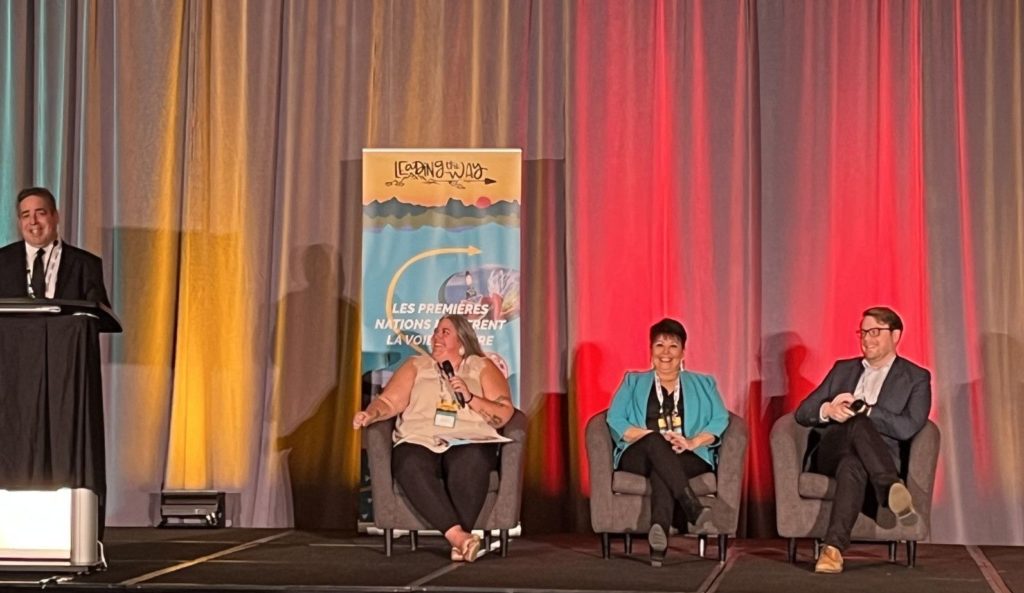From left to right: FNII Technical Advisor and panel moderator Jason Calla; Paula Pictou and Rose Paul of the Paqtnkek Mi’kmaw Nation; and James MacKinnon, Atlantic First Nations Water Authority.
When you’re a small First Nation with big plans, you use every tool you can to leverage your in-house expertise. For the Paqtnkek Mi’kmaw Nation in Nova Scotia that meant using services offered by all the institutes of the First Nations Fiscal Management Act – and a few more besides.
Paqtnkek Mi’kmaw (pronounced BUCK-in-keg MEEG-maw)) has 610 members. About 400 members live on the reserve, 22 kilometers from Antigonish, Nova Scotia. The reserve has some environmentally sensitive areas and is bisected by the TransCanada Highway, creating north and south sections that until recently were not connected. In short – there are a lot of obstacles to development of any kind.
That didn’t stop the community’s leaders, however.
“We decided long ago that economic development would be critical to our future,” said Paula Pictou, Lands Coordinator for the Paqtnkek Mi’kmaw Nation. “We wanted to get it right so we started working with national organizations established by the FMA.”
The First Nations Fiscal Management Act (FMA) provides the option for First Nations governments to have authority over financial administration laws, local revenues, and financing for infrastructure and economic development. The FMA institutions provide participating First Nations with support and tools to strengthen their communities and build their economies. Those institutions are:
• First Nations Financial Management Board (FMB)
• First Nations Finance Authority (FNFA)
• First Nations Tax Commission (FNTC), and
• First Nations Infrastructure Institute (FNII)
FNII, the First Nations Infrastructure Institute, was formally established in June last year to provide free services to support Nations to plan efficient and effective infrastructure projects. The institute has been working on two pilot projects – Paqtnkek is one of them (the other is Chippewas of Kettle and Stony Point Nation .)
“FNII is working with us to develop a business case to expand our water and wastewater systems to allow us to grow. We have plans for more member housing and phase two of our economic development project,” said Rose Paul, CEO of Bayside Development Corporation, Paqtnkek Mi’kmaw Nation.
Phase one of their economic development project is the Bayside Travel Centre which includes an Esso Commercial Card Lock, retail fuel bay, Bayside convenience store, Nova Scotia Liquor Corporation outlet (first in a Mi’kmaw community), Tim Hortons, Mary Brown’s Chicken, Bayside Entertainment Centre with provincially-licensed video lottery terminals, a By-the-Bay Visitor Information Centre, and a private truckers’ lounge.
Plans for phase two of the project include a centre that will feature a hotel and business park, including office space.
“We’ve come a long way since being told we could only have a small triangle of land to sell beads and trinkets,” said Rose.
That long journey included working with the Lands Advisory Board to develop a land code that was ratified in 2022. Using the authority of their land code, Paqtnkek has held community engagement sessions to develop a land use plan. The improvement and expansion of the water and wastewater system will enable the community to grow and realize the vision they have described through their land use plan.
As a member of the Atlantic First Nations Water Authority, Paqtnkek is using the land use plan to determine where future demand for infrastructure will be. The Authority is not an FMA institution, however it is a First Nations organization providing services to 29 member Nations in the Atlantic region.
“We are community-owned with a service approach that is accountable, equitable, and based on two-eyed seeing,” said James Mackinnon, Director of Engagement and Government Relations for the Authority. “We work on capital upgrades, funding and operations and management of water and wastewater systems.”
The support of all these various agencies gave Paqtnkek a strong foundation for negotiating with the province and working with other partners says Darcy Gray, a member of the Bayside Development team.
“You have reports on water use and wastewater and the needs of the community that’s been done and supported by the Atlantic First Nations Water Authority,” he said.
“You have the land management, land use planning and land code work. You have community engagement and conversation that gives you direction. And then when you’re sitting there talking with the province of Nova Scotia, expressing the importance of [the project] becomes a lot easier because you have the background, you have the plans, you have the supporting documentation and the technical information that you need.”
With all their careful planning, the Paqtnkek Mi’kmaw Nation is not building for the sake of building but rather generating business income to support current and future needs in health care, housing, education and recreation.
As Paula says, planning is key. “You need a plan. Use FNII. They’re there to help. You can’t go wrong!”
Rose says it’s helpful to make use of all the available resources when enacting ambitious plans.
“We couldn’t have done this on our own. Being able to utilize all the FMA tools made the difference. Use the tools to take control back for your Nation.”

